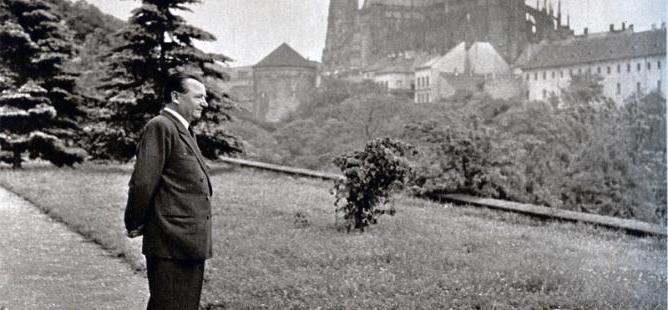Clement Gottwald is one of the first communist politicians in Czechoslovakia. He was the leader of the party, and the prime minister, and the president of this country. For some time there was even a cult of Gottwald, and his body was initially embalmed and became the subject of public viewing in the mausoleum. Cities and streets were named after him not only in their homeland, but also in other countries. But in the sixties of the twentieth century, they began to call him the Czechoslovak Stalin. Let's get acquainted with the biography of this politician.
Youth and first steps as a leader
Clement Gottwald was born in 1896 in the Austro-Hungarian city of Wischau (now it is located in the Czech Republic and is called Dedice). He grew up in the family of a peasant woman who was never married. In his youth, the future politician worked as a mahogany master, which he learned in Vienna. In 1912 he joined the Social Democratic Party. He was drafted into the Austro-Hungarian army during the First World War, fought on the eastern front. In 1921, he became one of the co-founders of the Communist Party and helped to publish its newspaper in Bratislava.
Takeoff
The career of the future President of Czechoslovakia begins to skyrocket from the mid-twenties of the twentieth century. In 1925 he was elected to the Central Committee of the party, and in 1929 he became Secretary General. In the same year, Gottwald was delegated to the National Assembly of Czechoslovakia as a deputy. In 1935 he became Secretary of the Comintern and left this post only after the dissolution of the latter in 1943. After the Munich Agreement of 1938, Clement Gottwald leaves for the Soviet Union, where he spends the next seven years in exile. From there, he begins to lead the Communist Resistance in Czechoslovakia.
Politician Clement Gottwald: biography of party leader
In March 1945, Eduard Benes, the pre-war president of the country and the head of the government in exile in London since 1941, agreed to form the National Front together with the Communists. Gottwald in this transaction got the post of deputy prime minister of the country. As for party affairs, he gave the post of Secretary General to Rudolf Slansky, and he himself took up a new position of Chairman.
In the 1946 election, he brought his political power to parliament with thirty-eight percent of the vote. This was the best result of the Communists in the history of Czechoslovakia. But by the summer of 1947, the popularity of this party began to decline rapidly, and many observers believed that Gottwald would lose his position. At this time, Italy and France began to oust the Communists from coalition governments, and Joseph Stalin advised Gottwald to do everything so that only one power remained in power. All this time, the politician pretended to be working in the government. In fact, he was plotting. The game was finished in February 1948, when the Cabinet of Ministers ordered Interior Minister Vaslav Nosek to stop accepting exclusively communists into the power structures. He refused with the support of Gottwald. Then 12 government ministers resigned. Gottwald, under the threat of a general strike, took the Communists in their place. Benes tried to resist, but under the threat of a Soviet invasion surrendered. From that moment on, Clement Gottwald became the most influential person in Czechoslovakia.

Top of power
On May 9, 1948, the National Assembly adopted a new Constitution. She was so pro-communist that Benesh refused to sign it. In June, he resigned, and a few days later Gottwald was elected president. At first, the new leader of the country tried to pursue a quasi-independent policy, but after meeting with Stalin, he sharply changed course. Clement Gottwald, whose photo began to be printed on the front pages of all Czechoslovak newspapers, quickly nationalized the country's entire industry and collectivized all agriculture. The government has begun serious resistance to such changes. Then Gottwald begins to purge. First, he expels from the authorities and arrests everyone who did not belong to the Communists, and then his party members who did not agree with him. The victims of these purges were Rudolf Slansky and Foreign Minister Vlado Clementis (shot in 1952), as well as hundreds of other people executed or thrown into prisons. The Czech writer Milan Kundera in his “Book of Laughter and Oblivion” talks about one case characteristic of such a leader of the Stalin type as politician Clement Gottwald. A photo of him dated February 21, 1948 shows the president of the country standing next to Vlado Clementis. When two years later, charges of treason were brought against the latter, the image of the former minister was destroyed by state propaganda.
Death. Czechoslovakia after Gottwald
For several years, the politician suffered from heart disease. A few days after visiting Stalin's funeral in 1953, he became ill. He died on March 14, 1956, at the age of fifty-six. His embalmed body was exhibited in the mausoleum, and the cult of his personality began in the country. But after six years, he was cremated and reburied in a closed sarcophagus. They say that the corpse began to decompose, because scientists incorrectly calculated the composition of embalming. And after the end of the communist era in the country, his ashes, along with the remains of twenty other party leaders, were reburied in a common grave at the Olšany cemetery in Prague. At the end of the eighties of the twentieth century there was an attempt to print his portrait on Czech banknotes, but it was so negatively accepted that all these bills were withdrawn from use.